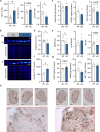Evidence of COMT dysfunction in the olfactory bulb in Parkinson's disease
- PMID: 40024917
- PMCID: PMC11872990
- DOI: 10.1007/s00401-025-02861-y
Evidence of COMT dysfunction in the olfactory bulb in Parkinson's disease
Abstract
Hyposmia is one of the most prevalent non-motor symptoms of Parkinson's disease and antecedes motor dysfunction by up to a decade. However, the underlying pathophysiology remains poorly understood. In this study, we investigated the mechanisms of dopamine metabolism in post-mortem olfactory bulbs from ten Parkinson's disease and ten neurologic control subjects. In contrast to the loss of dopaminergic neurons in the midbrain, we observed an increase in tyrosine hydroxylase-positive neurons in the Parkinson's disease olfactory bulb, suggesting a potential role for dopamine in the hyposmia associated with the condition. Using immunohistochemistry, high-performance liquid chromatography, western blot, and enzyme-linked immunosorbent assays, we demonstrate a reduction in catechol-O-methyltransferase catabolism of dopamine to homovanillic acid, potentially due to a depletion of the methyl donor substrate S-adenosyl methionine. We hypothesized that reduction in catechol-O-methyltransferase activity would result in increased dopamine occupation of the D2 receptor, and consequent inhibition of olfactory processing. Next, we conducted pharmacological interventions to modify dopamine dynamics in hyposmic tau knockout mice, which exhibit altered dopamine metabolism. Our hypothesis was supported by the observation that the D2 receptor antagonist haloperidol temporarily alleviated olfactory deficits in these tau knockout mice. This study implicates a potential role of catechol-O-methyltransferase-mediated dopamine metabolism in the early olfactory impairments associated with Parkinson's disease.
Keywords: Catechol-O-methyltransferase; Dopamine; Hyposmia; Olfaction; Parkinson’s disease.
© 2025. The Author(s).
Conflict of interest statement
Declarations. Conflict of interest: The authors declare no competing interests.
Figures




Similar articles
-
Bioactive phytoconstituent millettone as a potential inhibitor of catechol O-methyltransferase: Implications for neuroprotective therapy in Parkinson's disease.J Pharmacol Exp Ther. 2025 Jun;392(6):103592. doi: 10.1016/j.jpet.2025.103592. Epub 2025 Apr 25. J Pharmacol Exp Ther. 2025. PMID: 40378635
-
Signs and symptoms to determine if a patient presenting in primary care or hospital outpatient settings has COVID-19.Cochrane Database Syst Rev. 2022 May 20;5(5):CD013665. doi: 10.1002/14651858.CD013665.pub3. Cochrane Database Syst Rev. 2022. PMID: 35593186 Free PMC article.
-
Pathophysiological relationship between COVID-19 and olfactory dysfunction: A systematic review.Braz J Otorhinolaryngol. 2022 Sep-Oct;88(5):794-802. doi: 10.1016/j.bjorl.2021.04.001. Epub 2021 Apr 25. Braz J Otorhinolaryngol. 2022. PMID: 33965353 Free PMC article.
-
Catechol-O-methyltransferase inhibitors versus active comparators for levodopa-induced complications in Parkinson's disease.Cochrane Database Syst Rev. 2004 Oct 18;2004(4):CD004553. doi: 10.1002/14651858.CD004553.pub2. Cochrane Database Syst Rev. 2004. PMID: 15495118 Free PMC article.
-
Use of β-adrenoreceptor drugs and Parkinson's disease incidence in women from the French E3N cohort study.J Parkinsons Dis. 2025 Jun;15(4):789-804. doi: 10.1177/1877718X251330993. Epub 2025 Apr 29. J Parkinsons Dis. 2025. PMID: 40302366
References
Publication types
MeSH terms
Substances
Grants and funding
LinkOut - more resources
Full Text Sources
Medical
Miscellaneous

